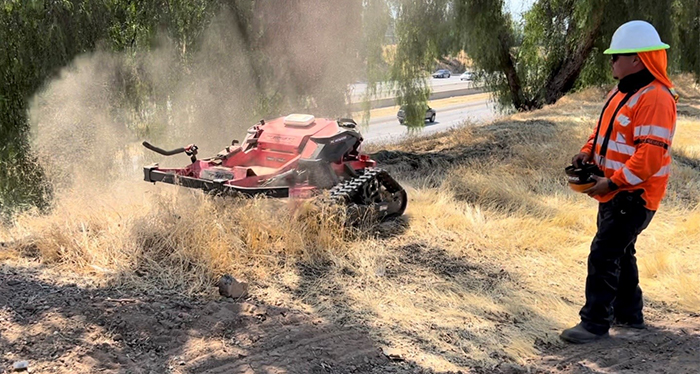Robot mowers lighten workload, increase safety

District 6 photograph
Remote-controlled machines tackle tight spots, help District 6 crews dodge dangers
Ever-evolving technology is helping to enhance efficiency and minimize roadside dangers for motorists and Caltrans landscaping crews. Robot mowers have made their way to various Caltrans districts and in the summer of 2023, they powered their way to District 6, which encompasses Fresno, Kern, Kings, Madera and Tulare counties.
With thousands of acres to maintain along California’s highways, Caltrans landscaping crews are tasked with a daunting amount of mowing and upkeep, in challenging conditions. The introduction of robot mowers has proven to be a game-changer.
A normal year’s workload combined with a precipitation-pounded winter like that of the 2022-2023 season equated to a substantial increase in what crews encountered along transportation corridors. District 6 enlisted the assistance of two remote-controlled mowers, more commonly known as robot mowers, to combat the growth while increasing the number of acres that could be landscaped in a workday.
Routine weed abatement on most of state right of way includes utilizing large-scale equipment to mow large flat areas, deploying multiple crew members armed with hand tools, or a combination of both. With the addition of the robot mower, crews can have the ideal combination of “small but mighty.”
Because of its mobility and dimensions, a robot mower can access areas that larger equipment may not be able to navigate. Its compact size in comparison to a large counterpart, however, is nothing to scoff at.
The robot mower can precisely cover a large amount of area with one operator controlling it, helping minimize how many crew members are needed for one task. By taking on the repetitive and labor-intensive task of mowing, these robots significantly reduce the workload of Caltrans crews, allowing them to focus on other essential maintenance activities.
These robot mowers are not just helping minimize workloads and increase efficiency. Their most prominent benefit is increased safety for crews.
Landscape maintenance alongside busy highways poses inherent risks for both motorists and Caltrans crews. Many California highways have steep embankments that require workers to mow and/or landscape by hand. Robot mowers can ascend and descend slopes and cover large areas, thereby drastically minimizing the need for manual labor.
Though robot mowers help reduce the amount of crew members needed to work in an area, staff are needed to help minimize the possibility of equipment striking an object that could result in a spark or fire igniting on state right of way. To help diminish the chances of this occurring, prior to working in the area, crews visually scan the area to identify potential hazards. This method is functional, but not infallible and because of this, crew members ensure that fire suppression equipment is present at all mowing operations and they are trained on proper usage.
Staff and supervisors recognize and appreciate that the use of these remote-controlled mowers helps minimize crews’ exposure to traffic, helps decrease trip and fall hazards, and increases the opportunity for steady footing for mowers’ operators.
The use of robot mowers and similar technology represents a move toward a more innovative, efficient and – most importantly – safer Caltrans that benefits our employees and the traveling public.
Source: Elizabeth Yelton, District 6 public information officer

